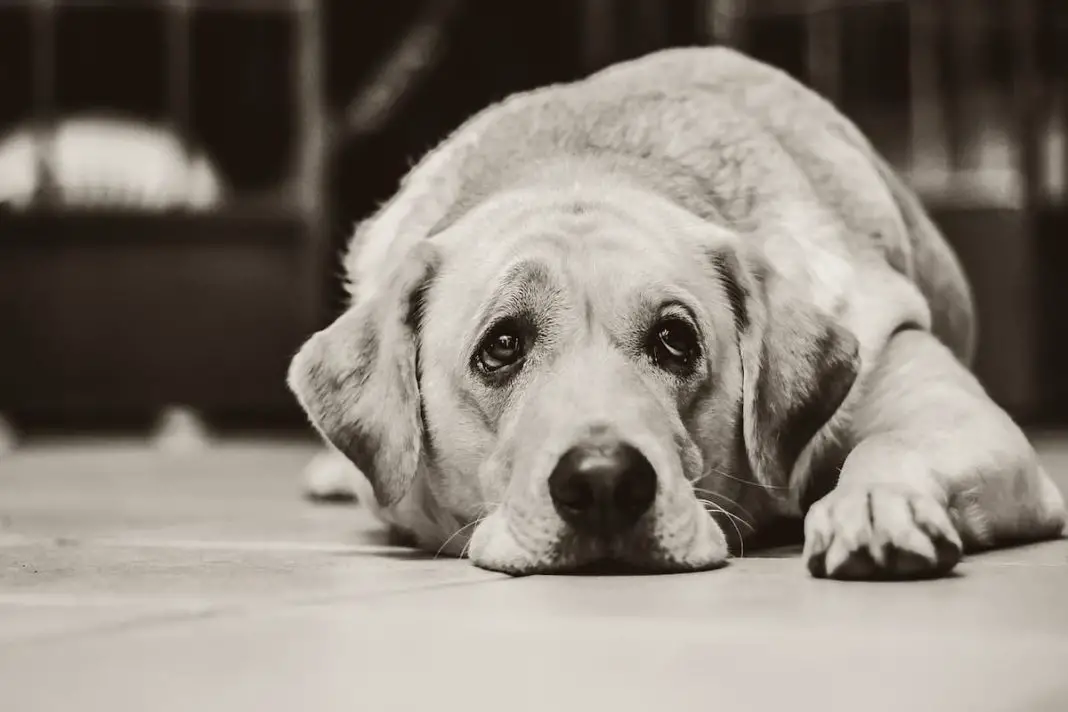Contents:
- Why Do Dogs Urinate When Submissive?
- Preventing Submissive Urination
- Preventing A Male Dog From Marking Territory In The House
- Other Practical Hacks
- Getting A Professional Involved?
So, your dog pees on your boyfriend’s side of the bed? To understand why your dog is peeing on the side of the bed that your partner sleeps on, you’ll need to pick your dog’s brain and perceive the world from their perspective. Once you take a walk in your dog’s shoes, will things start to make more sense.
Here we will go through the most probable cause your dog is peeing on the bed. We’ll first go through the possibility that your dog is peeing on one side of the bed to be submissive and the other possibility that your dog is doing it just to mark its scent.
And remember, whether your dog is young or old, your dog won’t be doing it out of spite or malice, as dogs don’t think this way! Instead, your dog will need all your love and understanding to get through this.
Why Do Dogs Urinate When Submissive?
Dogs that urinate submissively are trying to appease someone in the home that they see as being “socially dominant”. To escape from being punished, a submissive dog could pee when they’re greeted by the socially dominant person. This can become more of a problem for dogs that have had a history of rough treatment or punishment after inappropriate peeing. This is common in rescued dogs and shy, anxious, or timid dogs.
Preventing Submissive Urination
To fix submissive peeing, do not hit, scold, or yell at your dog after it has peed. Rather, attempt to build the dogs confidence by teaching it simple commands (sit, stay, come), rewarding them once they have been successful. This is the same reward-and-praise process you used to teach simple dog tricks (roll over, fetch). It’s also recommended that you interact with your dog using the following non-dominant postures:
- Avoid making direct eye contact with your dog, instead, you should approach your dog from the side, and crouch down to their level.
- When petting your dog, go for under the chin rather than petting the top of the head.
- Try keeping all greetings low key and take your dog outside to relieve itself as soon as you get home.
- If your dog pees on the bed, simply clean it up without fuss and go away. It’s always a good idea to reward and praise your dog when it pees in the appropriate spot.
Preventing A Male Dog From Marking Territory In The House
Is your dog a male? To stop a male dog from marking their territory in the house, you’ll first need to understand why they’re doing it. It’s common for a male dog to instinctively mark their territory to protect it from a perceived threat. This becomes more of a problem when there are new developments in the house like another person that has started to sleep in the bed, a new baby or a new pet your male dog is more likely to mark his territory. While it’s most certainly a frustrating behavior, remember that your male dog is marking their territory because they want to protect their family.
Step 1
Has your dog been neutered? An intact male dog is much more likely to mark its territory inside the home than a neutered one.
Step 2
Supervise your male dog at all times while in the house while training them to not mark. Confine your dog to a comfortable crate when you’re unable to supervise and correct their marking behavior.
Step 3
Use a belly band to catch urine, which helps to discourage territorial marking.
Step 4
If you notice your dog showing interest on your partner’s side of the bed, interrupt your dog before they have time to mark the bedsheets and take your dog outside. Give your dog praise when they urinate appropriately. Never punish your male dog for territorial marking, it will only harm your relationship in the long term.
Step 5
Establish yourself as the leader in your relationship with your male dog. Dog experts recommend establishing yourself as the leader with your male dog, which should help stabilize the relational hierarchy, reducing your dog’s drive to mark their territory.
Other Practical Hacks
Avoid Punishment-Based Methods
Avoid scolding your dog for peeing on the bed, (even an emotional “no!” could be too much for a soft dog), so refrain from pushing the puppy’s face in pee, or swatting them with a newspaper. Using these methods will only teach your dog that you are scary and next time your puppy will do it on the bed when you’re not looking.
Invest in Calming Aids
If you suspect your dog is peeing on the bed because of the stress of another person in the room, you can try some calming aids. For example, if your dog is scared of noises, you can buffer sounds using white noise such as a TV or radio turned or play a calming CD made just for dogs.
There are many calming aids available over the counter or over the internet like DAP collars and diffusers, Back Flowers and calming chews for dogs made of L-theanine. If your dog is dealing with severe stress, ask your vet for something stronger.
Prevent Access to your Bed
This may be a no-brainer, and the solution is easy, yet a lot of dog owners fail to even consider it. Try closing your bedroom door or place bulky items on the bed when you’re not around so that your dog is less tempted to jump up and mark their spot.
Clean Up Accidents Correctly
Although there are many ways of cleaning accidents on the bed, leaving any traces behind or using the wrong products, could encourage your dog to keep doing it because the bedsheets will smell like a bathroom to them.
You should avoid using ammonia-based products (the ammonia smells just like urine to a dog) and instead use an enzymatic cleaner like Nature’s Miracle.
Oh, and just in case you’ve missed any spots, there’s a little secret you can use. Have you ever seen those cool black lights that are used to look for scorpions? This blacklight can help you spot any soiled areas you might have missed, as urine under a black light becomes a bright fluorescent color at night so that you can detect and clean your bed properly.
Does Your Dog Have A Bed Of Its Own?
Have you considered giving your dog its own sleeping place? Although cuddling is wonderful, there is such a thing as too much togetherness. Your dog having their own space to sleep can be much less of a headache for you in the morning.
Getting A Professional Involved?
If you find that none of the above suggestions resolves your dog’s problem, you may seek guidance from a dog behavior professional, such as a dog trainer or dog behavior consultant. When looking for a professional, make sure they are committed to using positive reinforcement and force-free behavior modification.








